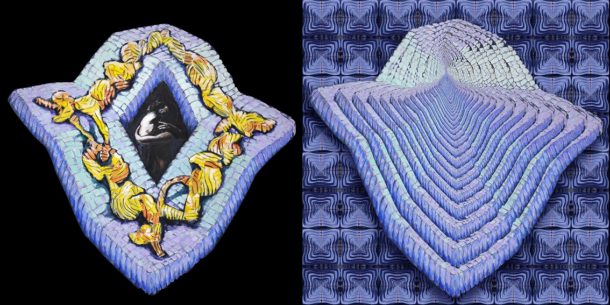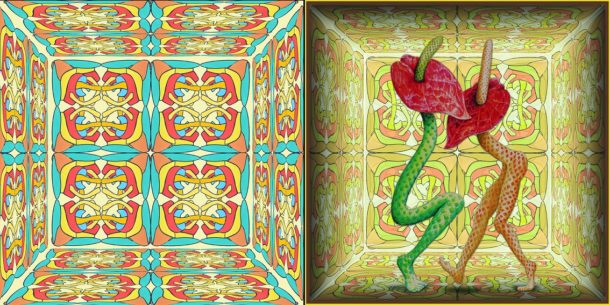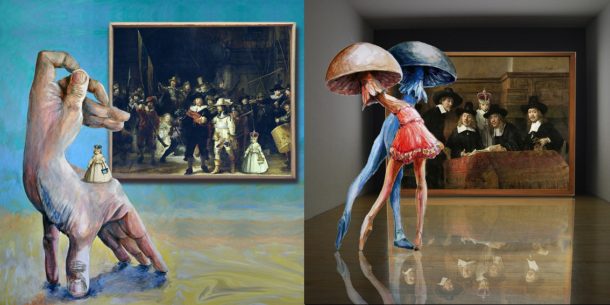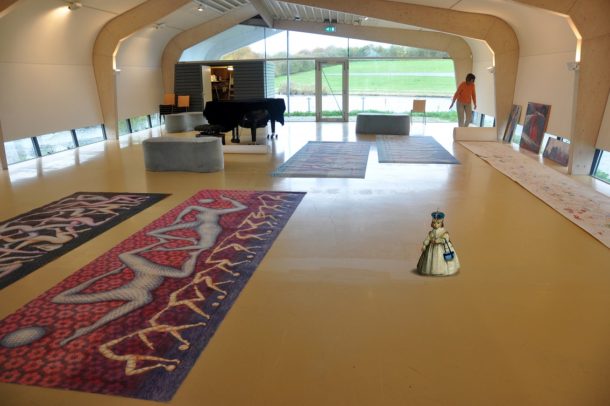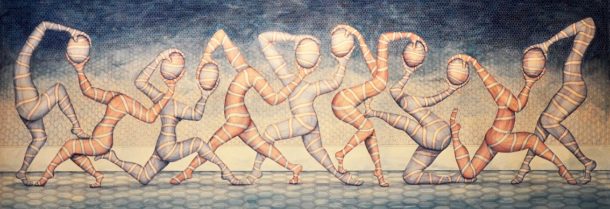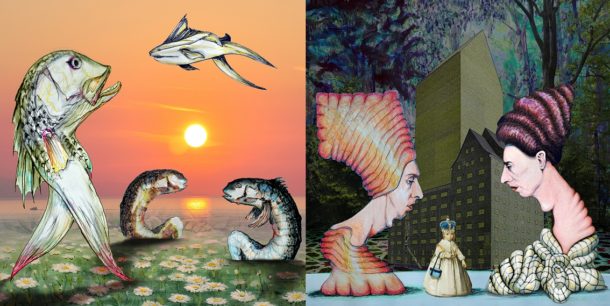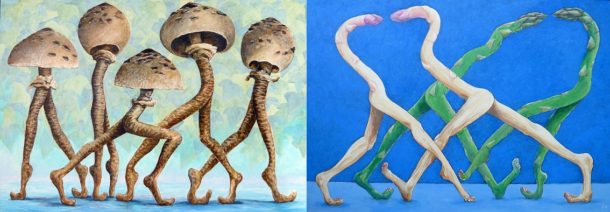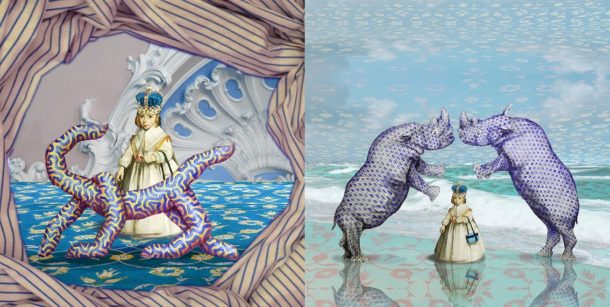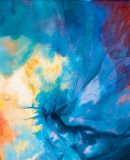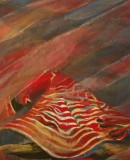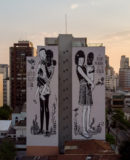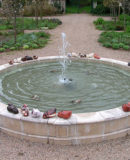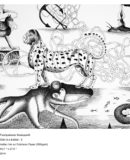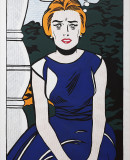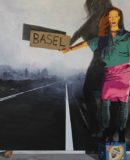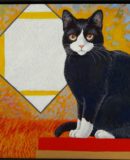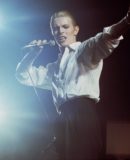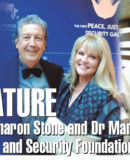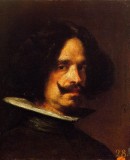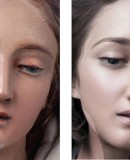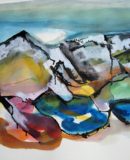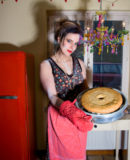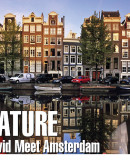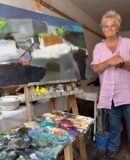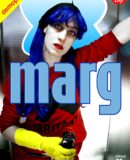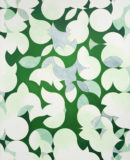World Fine Art Professionals and their Key-Pieces, 103 - Jan Coenen
World Fine Art Professionals and their Key-Pieces, 103 – Jan Coenen
Jan Coenen takes you into a particular universe. Legs, in a variety of positions and movements. Sometimes they run. Sometimes they turn into mushrooms, acorns or flowers. Ditto with hands. And complete bodies, often headless. At first sight a strange world which in retrospect is perhaps not so surprising.
I met Jan Coenen at the opening of the Dutch Digital Art Museum in Almere, early October. On two screens, he showed digital collages, composed of his own paintings, drawings, paper collages and digital photos plus some works from the Rijksmuseum’s website. In one work he takes a painting as starting point, doubles this, one, twice, three times until the entire screen is filled with a pattern. Especially when there are multiple colors, it has similarities with the work of Christie van der Haak.
In another work, he begins with an own painting and combines that with fragments of drawings, or he uses an image of a little girl of a painting of Gerard ter Borch from 1648, puts a crown on her head and moves her to his own work. There she appears between the legs, hands or fingers and even on Rembrandt’s Night Watch, he finds a place for the little princess. Her name is Helena van der Schalcke. Ter Borch portrayed her when she was two years old. She has not gotten over 25 years, but she lives on as a two year old for over 350 years, since 1898 in the Rijksmuseum and now in the digital world, crowned by an inhabitant of the bottom of the Zuiderzee.
Sketchbooks
A week later I’m at Jan Coenen’s home, his house in Almere. He takes five sketchbooks out of the bookcase. I see the exercises which can then lead to the surrealist paintings. From a briefcase he gets more sketchbooks. “I have always at least one in my pocket and draw at stations and on trains, at meetings and during phone conversations. Upstairs I have another fifty sketchbooks with drawings. I use them today as the basis for my digital work. I make a picture of it and then go to play with it on the computer, so they get a second life.” In his enthusiasm he made so many paintings that he has a storage problem. Many works are now only stored digitally and no longer being painted.
In 2013, Jan Coenen had a retrospective of his work in Lelystad, in Loods 32. From floor to ceiling that space of 10×20 meters was filled with his paintings, about 300 pieces and also some drawings. Including a painting of 1½ to ten meters with people, flowers and trees in various mixtures.
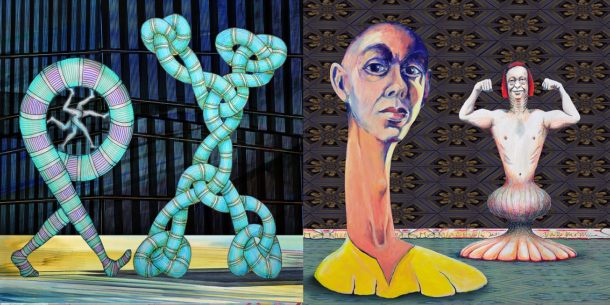
Robert Musil
“To make a good painting is difficult. The work should be well technically and in terms of performance. Surface, shape, color should be good, from afar but also from so close that you don’t see the composition anymore. A painting of mine should also contain a deeper level, raise questions, otherwise I do not find it interesting. But it must at the same time have something beautiful, something recognizable, so that the viewer can connect with the painting. A painting should read like a poem and the oeuvre of an artist as a novel.”
In 2015, he along with Gonny Geurts had an exhibition at the art space ‘De Verbeelding’ in Zeewolde with literature as theme. Geurts had dedicated herself to poetry and Coenen to prose. On 18 linear meters of paper he had drawn tens of thousands of lines.
Coenen: “I had made four drawings from four and half to one and a half meters that I made with the ‘mandrel’, which used to be in every passer box and which was used for technical drawings in ink, but which can also be used well with acrylic paint. Some 160.000 lines I have drawn, 40.000 per drawing. While drawing, I listened to an audio book, in German, ‘The Man Without Qualities’ by Robert Musil. That book takes 63 hours, it was a special experience. I drew headless bodies, said bodies passed their head to other bodies. If heads are the conscience, then here a collective conscience is represented as the sharing of conscience of individuals.
An important character in the first part of The Man Without Qualities, a German industrialist, argues that a worker can not be held responsible for the end product of his labor if he only gives a small contribution. A collective conscience must be composed of all workers who contribute. The increased complexity of the labor requires that the conscience must be redefined. That was the case 100 years ago, when Musil wrote his book and is still current now it has been found that that the individual conscience should not be switched off and replaced entirely by the collective, think for instance of the discussion on self-enrichment and top salaries.”
Be a genius
In all these figures and movements Coenen’s theme comes forward: man who is looking for something. “It’s about people who are missing something, a place in the group for example. And it also relates to the artist looking for a story, a message, a subject. If you extend it even further: What do you do with your life and why you do it?”
Coenen: “In his book Musil raises the question of becoming a genius. That the protagonist wants to, he will get respect, he thinks. He tries, as a mathematician and in other ways. Then he reads ‘Horse race won by a genius horse’. ‘What sense does it make to want to be a genius?’ he thinks. Therefore, he takes a year off from reality, losing all mandatory standard ambitions and focuses himself on the possibility. Who would, after all, dream of the here and now? We’re always longing for something else. I read that book for the first time when I was twenty-five. And that has become my theme: not reproducing reality, but of the possibilities. In the virtual world, social media etc. the dividing line between reality and fiction has become much more blurred. An old theme with topicality.”
Jan Coenen is not easily satisfied. Sometimes there is something successful, but never completely. “That discontent drives you to try again, pushes you on. You want to show what can be improved, in the first place to yourself. It becomes a part of your personality, you’re constantly searching. The work is never finished, there is no ultimate end result. That might also be true for other artists; take the Night Watch. Perhaps Rembrandt also had liked to change some parts in the Night Watch. If he were alive today he might have gone on with digital tools.” Coenen has given an example of how this would have been possible with integrating Helena van der Schalcke in the front of Rembrandt’s painting. “There was room. Everywhere there is still room for change.”
Artists Association Flevoland
Jan Coenen has been an artist for more than forty years. After graduating as a geologist, art attracted. Every week he got lessons from a former teacher of the Art Academy, Mr. Van Amstel. Then he attended the Academy of Fine Arts in Amsterdam, the teachers academy. “Just when I had finished, the BKR, the Visual Artists Scheme, was abolished. It was not easy in the arts. That is why I switched to IT, where I still work, thirty years later, now as an IT architect for 28 hours a week.”
But drawing continued, if you look at his notebooks filled with doodles between the notes. “You can nicely offset the stress of the day by drawing and painting in the evening. Drawing and painting, especially fill-work patterns, you can combine with other things, as for example, watching a talk show or a football game. If it gets really exciting, you’ll hear it. It’s nice that through the IT work it ain’t necessary to sell and I can make what I want. I like to do assignments, it’s a pleasure listening to the wishes of other persons. In this way you overcome the tendency to always do the same. Further I regularly participate in projects of the Artists Association Flevoland. I learn from the work of my fellow artists. You look with different eyes. The Museum of Digital Art is also a great incentive to get started with digital means.”
Daily Jan Coenen puts a new digital collage on Instagram. See: https://www.instagram.com/jancoenen1/
Mushrooms
The wife of a colleague was active in the Dutch Mycological Society. ”He knew I was painting and asked if I wanted to make a mushroom painting for his wife. One thing led to another and so I ended up with paintings on the celebration to mark the 100th anniversary of the association. At the Museum De Locht in Horst, I then three years graced the ‘Day of the Champignon’ with paintings of mushrooms and asparagus.
Coenen: “Mushrooms are beautiful and have a deeper meaning. They are associated with autumn, vulnerability and decline. They have an invisible network in the ground. They taste delicious and can also work mind-blowing. Why ain’t there actually moving mushrooms, I wondered. Apparently this did not succeed in evolution. Asparagus are special as well because of the elegance and fragility and because they are white as long as they remain in the ground and discolor once they see light.
Flevoland and art
Finally we talk about Almere, Flevoland and the arts. The province mainly focuses on the promotion of landscape art. Museum the Pavilions had to close its doors several years ago. “In a way it was a bit too elitist for the population. The municipality of Amersfoort bought the pavilions, initially without having a destination. I found that sale a pity, especially for an architectural city like Almere. The Police and Fire Brigade Museum did come, for this they found money. The province still has a hefty backlog compared to the old country. And there is also Corrosia in Almere with a limited number of expositions per year with little regard for Almere artists. Almere further has Kunstlinie, a modern building designed by a Japanese architect, which was put down in the good years, but does not really meet the needs of the population, which is artistic activities for a small fee. And this in the seventh city in the Netherlands, which recently enrolled its 200.000th resident. Look at the cities that are slightly larger, Groningen and Tilburg, both of which have a magnificent art museum. We are now trying to get the Dutch Digital Art Museum off the ground, which can better reflect the needs and desire of the people. Till now there are minimal resources.”
“I am also a member of KVF, the artists association of Flevoland, there is good cooperation between the artists with regular new projects. That is a positive point in the artistic climate of Flevoland.”
http://www.flevokunst.nl/
http://ddama.eu/
http://ifthenisnow.eu/nl/verhalen/de-wereld-van-de-flevo-kunstenaar-1-jan-coenen
Disclaimer: The views, opinions and positions expressed within this guest article are those of the author Walter van Teeffelen alone and do not represent those of the Marbella Marbella website. The accuracy, completeness and validity of any statements made within this article are not guaranteed. We accept no liability for any errors, omissions or representations. The copyright of this content belongs to Walter van Teeffelen and any liability with regards to infringement of intellectual property rights remains with the author.

